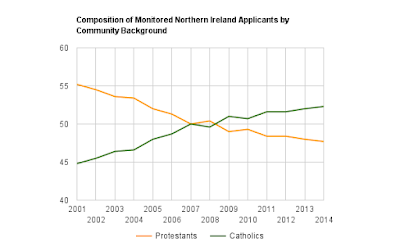Following on from the publication of the
24th Fair Employment Monitoring Report by the Equality Commission comes the publication of the
Labour Force Survey 2013.
For as long as the correlation between demographic and voting trends remains strong, I will continue to review publications such as these for information provided on demographics, in order to gage possible future voting patterns.
The main difference between the LFS and Monitoring Reports is that the latter does not monitor the self-employed, those on government training schemes, school teachers and those working in private sector concerns with 10 or less employees. While the LFS does look at a wider market spectrum it comes with a health warning in that as a survey the results can be quite volatile due to sampling errors. Also data to determine the community background figures where religion was not provided by those surveyed has not been used in the LFS.
Comparing the figures for the
Working Age Population with the LFS 2012 we see that the proportion of Protestants has increased by one percentage point to 45%, the proportion of Catholics remains unchanged at 43%, while the proportion of those classified as 'other/non-determined decreased by one percentage point to 12%.
The definition of "working age" changed in 2010 to include both males and females between the ages of 16 and 64 (previously it excluded females between ages 59 to 64). Therefore we will look at the figures from 2010 in order to be as consistent as possible.
The Protestant proportion increase of 1% in 2013 makes as much sense as a 2% decrease in both 2011 and 2012. It is clear the volatility of the LFS can cause year on year changes which are contrary to demographic trends. The LFS recognises this volatility stating "it may be due to sampling error and as such year on year changes should be observed with caution and longer term trends should also be considered." The longer term trends are represented in the graph below.
The LFS also gives us a breakdown of the demographics for the
Population Aged 16 and Over. We are told "The proportion of Protestants has fallen by eight percentage points between 1990 and 2013, from 56% to 48%, while the proportion of Catholics has increased by three percentage points, from 38% to 41%, over this same period. The proportion of the population classified as ‘other/non-determined’ has almost doubled (from 6% to 11%) over this period".
In the graph above we again can see can see the volatility of the results from year to year. The longer term trend is demonstrated below:
The demographic breakdown of the
Population Aged 60+ tells us "the proportion of this age group who identified as Protestant has decreased from 66% in 1990 to 60% in 2013, while the proportion of Catholics has increased, from 30% to 33%, over this same period. Five per cent of those aged 60 and over were classified as ‘other/non-determined’ in 1990; by 2013 this proportion had increased to 8%. We are also told Between 2011 and 2012 the proportion of Protestants fell by six percentage points (from 62% to 56%), the proportion of Catholics increased by eight percentage points (from 29% to 37%), and the proportion of those classified as other/non-determined decreased by two percentage points (from 9% to 7%). Such a large swing in the religious composition of the population of this age group may be due to sampling error and as such year on year changes should be observed with caution and longer term trends should also be considered"
The breakdown of the
Population Aged 16 to 24 tells us "The proportion of Protestants has fallen by seven percentage points between 1990 and 2013, from 49% to 42%, while the proportion of Catholics has increased by one percentage points, from 44% to 45%, over this same period. The proportion of the population classified as ‘other/non-determined’ has almost doubled (from 7% to 13%) over this period".
The data on the 'Working Age Population' shows that the population between the ages 16 to 64 is at or very close to parity. The data on 'Population Aged 16 & Over' and 'Population Aged 60+' telling us there are significantly more Protestants in the older age cohorts. The data on 'Population Aged 16 to 24' shows us that Catholics are in a majority in the younger age cohorts. We can therefore conclude that tipping point for the 'Working Age Population' will be seen in the LFS 2014 and if there is a sampling error in 2014 we will see it in the 2015 report.




















